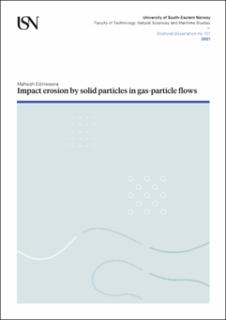| dc.contributor.author | Ediriweera, Mahesh | |
| dc.date.accessioned | 2021-06-16T13:48:02Z | |
| dc.date.available | 2021-06-16T13:48:02Z | |
| dc.date.issued | 2021-06-18 | |
| dc.identifier.isbn | 978-82-7206-609-2 | |
| dc.identifier.issn | 2535-5252 | |
| dc.identifier.uri | https://hdl.handle.net/11250/2759821 | |
| dc.description.abstract | Mass loss of inner wall surface due to particle impact, also referred as erosive wear, is a common challenge encountered in industrial pneumatic conveying systems. Previous studies have shown that erosion is a process involving many parameters and a combination of several wear mechanisms. Though a large number of fundamental and analytical mechanisms/models are available to explain the phenomena, there is no fully defined comprehensive description to predict erosion rate accurately.
In the present study, a sand blast type erosion tester was used to investigate the erosion process on mild steel (DOMEX 355MC) surface. The effect of particle size, impact angle, exposure time (amount of erodent) on impact erosion was analysed by univariate tests. Morphology of the eroded craters produced by a stream of air-borne dolomite particles were studied by a surface profilometer. Topographic measurements of the profilometer provided the dimensions of the surface profile, estimation of maximum penetration and slope inside the crater. Based on univariate tests, multivariate analysis was carried out with six variables to determine significant variables using the Design of Experiments methodology. This methodology resulted in selection of four significant variables which were used to calibrate a Partial Least Squares Regression (PLS-R) model that allows a closer study of the influence of the main variables and their interactions.
Mass loss against impact angles changed considerably with exposure time due to changes of the surface during the erosion process. It was noticed that the effective impact angle (impact angle measured inside the crater) had changed with the expansion of the crater. The change of effective impact angle causes to change the dominance of the erosion mechanism on the eroded surface and consequently the erosion rate. The effective impact angle was calculated for different exposure times to understand the change of erosion rate with time. The penetration depth was highest at low impact angles. The critical impact angle corresponding to the maximum penetration depth changed with the exposure time. The knowledge of how the particles penetrate into the surface as a function of exposure time can be useful in determination of the material thickness when designing equipment with longer durability.
The effects of four significant main variables were identified by the statistical model. The model predicted promising results, however, the validity of the model is limited to the tested conditions and the materials. Impact angle and impact velocity had high effects on erosion. Generally, erosion increased with higher impact velocity and decreased with increase in impact angle. Impact velocity had a higher effect at low impact angles than at high impact angles, revealing an interaction between the two variables. Increase in surface temperature and particle size of bulk material also resulted in higher erosion, however, the effects of these two variables were lower compared to the effects of the impact velocity and the impact angle. Surface temperature had a higher effect on erosion than the particle size within the tested conditions. | en_US |
| dc.language.iso | eng | en_US |
| dc.publisher | University of South-Eastern Norway | en_US |
| dc.relation.haspart | Paper 1: Ediriweera, M., Chladek, J. & Ratnayake, C.: Effect of impact angle, exposure time, and particle size on impact erosion. Particulate Science and Technology 39(1), (2021), 10-18. https://doi.org/10.1080/02726351.2019.1663328. Not available online | en_US |
| dc.relation.haspart | Paper 2: Ediriweera, M., Chladek, J., Røyset, A. & Ratnayake, C.: The progression of impact erosion with exposure time. Manuscript submitted to Particulate Science and Technology. Not available online | en_US |
| dc.relation.haspart | Paper 3: Ediriweera, M., Arneberg, R., Chladek, J. & Ratnayake, C.: Multivariate analysis of impact erosion by Dolomite particles. Proceedings of the 9th International Conference on Conveying and Handling of Particulate Solids, CHoPS 2018, London, 10th-14th September 2018 | en_US |
| dc.relation.haspart | Paper 4: Ediriweera, M., Halstensen, M., Arneberg, R., Chladek, J. & Ratnayake, C.: Multivariate modelling of key variables in solid-particle erosion. Manuscript submitted to Tribology - Materials, Surfaces & Interfaces. Not available online | en_US |
| dc.rights.uri | http://creativecommons.org/licenses/by-nc-sa/4.0/deed.en | |
| dc.title | Impact erosion by solid particles in gas-particle flows | en_US |
| dc.type | Doctoral thesis | en_US |
| dc.description.version | publishedVersion | en_US |
| dc.rights.holder | © The Author, except otherwise stated | en_US |
| dc.subject.nsi | VDP::Teknologi: 500::Materialteknologi: 520 | en_US |

